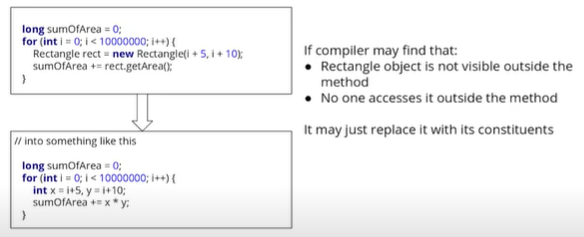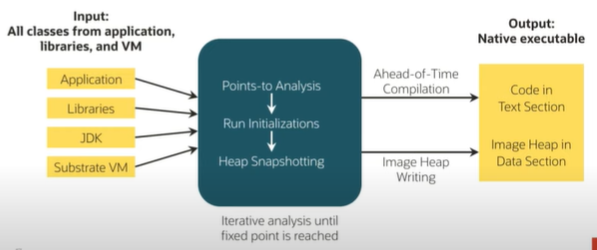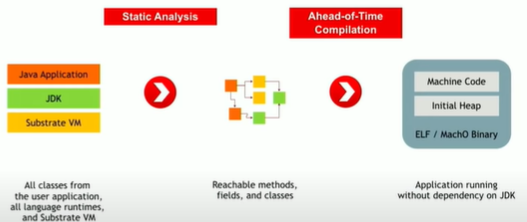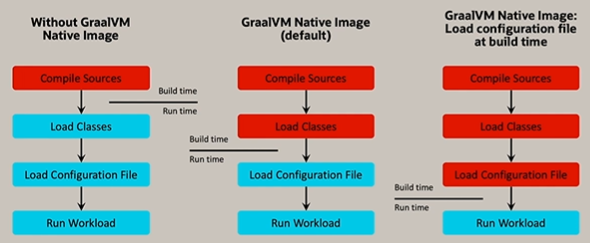graalvm-notes
- references
- New opportunities for Java developers with GraalVM - Oleg Šelajev
- Particle Accelerators and Java with Quarkus - Burr Sutter
- Micronaut, Dragon-Slayer (Spring/boot) or just another framework - Vladimir Dejanović
- WJUG #254 - Robert Witkowski: Micronaut
- Evolving Java for the Serverless Era with Micronaut by Graeme Rocher
- 2019 - Maciej Przepióra - The need for speed. What is GraalVM and how can it help you?
- Maximizing Applications Performance with GraalVM
- Quarkus
- Maximizing Performance with GraalVM
- Ahead of Time Data Access with Micronaut by Graeme Rocher
- Quarkus why, how and what by Emmanuel Bernard
- Abstractions Without Regret with GraalVM by Thomas Wuerthinger
- GraalVM native images explained by Oleg Šelajev
- Running Spring Boot applications as GraalVM native images by Sébastien Deleuze
- Micronaut Deep Dive by Graeme Rocher
- Twitter's quest for a wholly Graal runtime - Voxxed Days Singapore 2019
- New opportunities for Java developers with GraalVM. Alina Yurenko, Oracle
- Quarkus and GraalVM: booting Hibernate at supersonic speed, subatomic size by Sanne Grinovero
- GOTO 2020 • Maximizing Java Application Performance with GraalVM • Oleg Šelajev
- Deep dive into using GraalVM for Java and JavaScript developers by Oleg Šelajev, Thomas Wuerthinger
- JIT and AOT in the JVM with Mark Stoodley
- Charlie Gracie: Current state of JVM Escape Analysis and downstream optimizations
- 4Developers Wrocław 2019: Deep dive into GraalVM. To JIT or not to JIT [ENG], Denis Dushyn
- https://www.stefankrause.net/wp/?p=64
- https://www.ibm.com/developerworks/java/library/j-jtp09275/index.html
- https://www.graalvm.org/reference-manual/native-image/SubstrateVM/
- https://medium.com/graalvm/improving-performance-of-graalvm-native-images-with-profile-guided-optimizations-9c431a834edb
- https://en.wikipedia.org/wiki/Ahead-of-time_compilation
- https://medium.com/@sauravomar01/ahead-of-time-vs-just-in-time-in-java-8456f5a77e00
- https://stackoverflow.com/questions/46579565/is-ahead-of-time-compilation-available-in-java-9
- https://en.wikipedia.org/wiki/GraalVM
- https://www.beyondjava.net/truffle-compiler-compiler
- https://en.wikipedia.org/wiki/Partial_evaluation
general
- hotSpot is optimised for data center deployments, not cloud
- we need instant startup and low footprint today
- GraalVM offers both a JIT compiler and an AOT compiler for Java
- interpreter vs compiler
- in a nutshell: compiler runs in advance, whereas the interpreter works on-the-fly
- interpreter reads program line-by-line and generates the machine code of the line on-the-fly
- it forgets about the previous line, so loops are translated time and again to machine code
- interpreter vs compiler
- polyglot
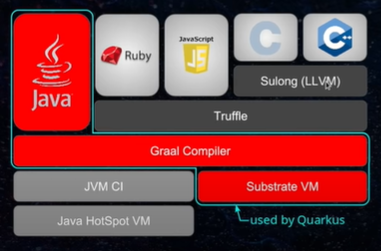
- written in java
- integration with VM using JVMCI (jvm compiler interface - available since java 9)
- truffle context
- a language abstract syntax tree interpreter which allows implementing languages on top of the GraalVM
- it's an API providing everything you need to write an interpreter, plus a framework
allowing you to leverage partial evaluation
- Futamura projections
- pros
- startup speed
- peak throughput
- reduced max latency
- small packaging
- low memory footprint
- compilation pipelines
- OpenJDK default
- javac => interpreter => C1 JIT => C2 JIT
- GraalVM JIT mode
- could be used as JIT C2
- javac => interpreter => C1 JIT => GraalVM JIT
- GraalVM AOT mode
- javac => GraalVM AOT
- OpenJDK default
- vs C2
- easier to understand
- modular design
- better inlining and escape analysis
- partial escape analysis
- a variant of escape analysis which tracks object lifetime along different control flow paths of method
- an object can be marked as not escaping along one path even though it escapes along a different path
- even if object can escape the method, graalvm assumes that it won't and start to use normal escape analysis
- if object is not on the heap but in the stack you could do more things
- allows for
- partial escape analysis
ahead of time compilation (AOT)
- is the act of compiling a higher-level programming language such as C or C++, or an intermediate representation such as Java bytecode into a native (system-dependent) machine code so that the resulting binary file can execute natively
- aot vs jit
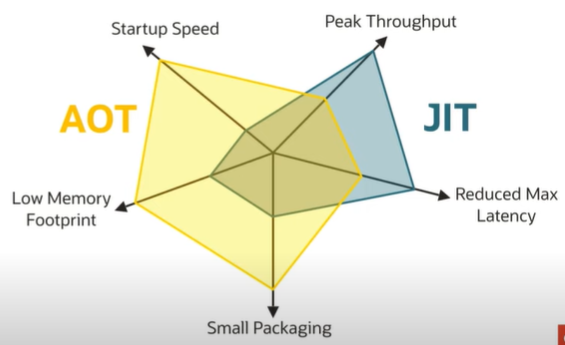
- default: image build fails when a reachable class is missing
- guarantees no linking errors at runtime
- default: image build fails when a reachable class is missing
- is enabled in Java 9
- jaotc compiler
- no longer platform neutral
- different AOT code needed for each deployment platform (Linux, Mac, Windows)
- potential risk - static initializers are resolved at compile time
class HelloCachedTime { static final Date CACHED_TIME = Startup.TIME; public static void main(String args[]) { System.out.println("Startup: " + CACHED_TIME); System.out.println("Now: " + new Date()); } } class Startup { static final Date TIME = new Date(); }- javac HelloCachedTime.java, java HelloCachedTime
Startup: Fri Aug 31 13:17:05 PDT 2018 Now: Fri Aug 31 13:17:05 PDT 2018 - native-image HelloCachedTime, ./hellocachedtime
Startup: Fri Aug 31 13:22:12 PDT 2018 Now: Fri Aug 31 13:17:05 PDT 2018- remedy: use flag
--delay-class-initialization-to-runtime=class
- remedy: use flag
- javac HelloCachedTime.java, java HelloCachedTime
native images
-
single, self-contained executable
- contains all the application code as well as necessary runtime support, ex. the garbage collector
- image build fails when a reachable class is missing
- guarantees no linking errors at runtime
- image build fails when a reachable class is missing
- easily copied
- no need to seek for various JAR, properties & other miscellaneous files and wait for them to open, load and initialize
- gives us instant startup
- contains all the application code as well as necessary runtime support, ex. the garbage collector
-
able to capture a snapshot of an application memory
- when native executable is started it continues exactly from where it was (snapshot)
- eliminates repetitive initialization
- makes the startup time even more instant
- class initializers, initializers for static and static final fields
- class initialization at image build time improves app startup
- by default, app classes are initialized at runtime
- most jdk classes are initialized at image build time
- makes the startup time even more instant
- do things once at build time instead at every application startup
- examples for objects in the image heap
- java.lang.Class objects, enum constants
-
lower memory consumption
- closed-world principle
- what is not known to be true, is false
- absence of information is interpreted as negative information
- analysis needs to see all bytecode
- otherwise aggressive AOT optimizations are not possible
- otherwise unused classes, methods, and fields cannot be removed
- otherwise a class loader / bytecode interpreter is necessary at runtime
- when building a native executable, GraalVM operates with a closed world assumption
- it analyzes the call tree and removes all the classes/methods/fields that are not used directly
- what is not known to be true, is false
- no meta-data for dynamically loaded classes
- no profiling data
- no JIT compiler data structures
- no dynamic code cache
- closed-world principle
-
trade-offs
-
can only run on a single platform
- if you generate the image for 64-bit Linux, it only runs on Linux
- portability is restricted compared to classical JAR file
-
ability to perform reflection is limited
- is still possible, but it has to be configured and compiled into the native executable
-
no dynamic classloading (everything is known at compile time)
- no dynamic proxies
-
when the application runs for a long time, the just-in-time compiler can actually outperform the AOT one
On the other hand, everything is always a tradeoff. Long running applications on traditional JVMs are still demonstrating better performance than GraalVM native executables due to runtime optimization. The key word here is long-running; for short-running applications like serverless functions, native executables have a performance advantage. So, you need to decide yourself between fast startup time and small size (and the additional step of building the native executable) versus better performance for long-running applications.
heliodon.io team
-
GraalVM native use non-parallel gc
-
-
native image build process
-
SubstrateVm
- native image tool (part of GraalVM) which focuses on AOT compilation
- takes a regular Java application and compile it into native binary
- re-implementation of the JVM on a completely different basis
- produces small, HotSpot independent code that starts fast and runs well in cloud based environment
quarkus
- price to pay for spring boot: memory, cpu, start-up
- because of proxies, injections, reflections, scan all the code etc
- supersonic?
- fast boot
- subatomic?
- low memory, high density
- why?
- high memory consumption & long start-up time is problematic if cloud
- start-up + first response
- spring boot + openjdk - 5 seconds
- quarkus + openjdk - 2.5 seconds
- quarkus + GraalVm - 0.055 seconds
- applicable for serverless
- perfect fit for event-driven environments where we need to spin up a service in real time to react to an event
- fast boot time = instant scale up
- makes a difference if we only want to scale in cloud - and we want to have low first response time
- under the hood
- SubstrateVm
- superpower: dead code elimination
- analysis a whole graph of app and delete not used code
- only the portions of frameworks (including the JDK itself) actually in use by the service are included in the resulting image
- for example: if you use hibernate and not use oracle - you don't need around 100 classes
- superpower: dead code elimination
- SubstrateVm
- hot reload
quarkus:devprovides hot-reload capabilities- changes made to source and configuration files are automatically re-compiled once the browser is refreshed
- how a traditional stack works
- search for configuration files, parse them
- classpath scanning to find annotated classes
- discover extension points, plugins, optional features
- build the metamodel
- prepare injection points
- generate proxies
- enhance classes
- validate the world
- jandex - high performance classpath scanner & indexer: avoids any class initialization
- arc - CDI based dependency injection, at build time
- gizmo - bytecode generation library, used by extensions to generate all infrastructure
micronaut
- a microservices and serverless focused framework
- library/toolkit vs framework
- when you use a library, you are in charge of the flow of the application
- you are choosing when and where to call the library
- when you use a framework, the framework is in charge of the flow
- it provides some places for you to plug in your code, but it calls the code you plugged in as needed
- when you use a library, you are in charge of the flow of the application
- reflection free, runtime proxy free, no dynamic classloading
- library/toolkit vs framework
- designed from the ground-up for Microservices and Serverless Computing
- a lot of cloud-native features
- service discovery
- distributed tracing
- asynchronous communication
- retriable http clients
- circuit breakers
- scalability and load balancing
- external configuration
- a lot of cloud-native features
- DI/AOP approach
- reflection based
- no common reflection cache in java, each library/framework produces a unique reflection cache
- extremely difficult to optimize memory consumption
- reflective calls are difficult for the JIT to optimize
- traditional AOP has heavy reliance on runtime proxy creation
- slows app performance
- makes debugging harder
- increases memory consumption
- no common reflection cache in java, each library/framework produces a unique reflection cache
- micronaut
- processes classes at compile time and produces all metadata at compile time
- doesn't need to scan all your classes, methods, properties to "understand" your app
- uses Ahead of Time (AOT) compilation via annotation processors
- pros
- improves startup perfomance
- reduces memory consumption
- reducing proxies and stack trace size
- improving debugging
- reflection based
- data access approach
- existing data access solutions
- spring data, gorm etc
- rely heavily on reflection and runtime proxies
- must compute queries at runtime
- cost of computation grows as your application grows
- micronaut
- precomputes queries at compilation time
- uses micronaut's reflection-free aop
- zero runtime overhead database access solution
- compilation time checking
- smaller stack traces
- jpa-ql and sql currently supported
- existing data access solutions
- solutions
- problem: limited annotation API
- solution: precomputed AnnotationMetadata
- problem: type erasure
- solution: precomputed Argument Interface
- problem: slow reflection
- solution: eliminate reflection
- problem: reflective data caches
- solution: zero data caches
- problem: classpath scanning
- solution: no classpath scanning
- problem: slow dynamic class loading
- solution: no dynamic class loaders
- problem: limited annotation API

